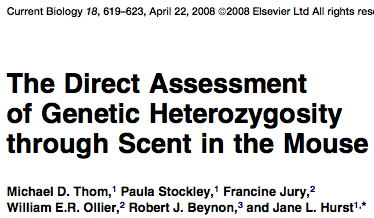MUPs advertise heterozyygosity and fitness

Thom MD, Stockley P, Jury F, Ollier WE, Beynon RJ, Hurst JL. (2008) The direct assessment of genetic heterozygosity through scent in the mouse. Curr Biol. 18, 619-623.[PUBMED][PDF]
The role of individual genetic heterozygosity in mate choice is the subject of much current debate. Several recent studies have reported female preference for more heterozygous males, but the mechanisms underlying heterozygote preference remain largely unknown. Females could favor males that are more successful in intrasexual competition, but they could also assess male heterozygosity directly at specific polymorphic genetic markers. Here, we use a breeding program to remove the intrinsic correlation between genome-wide heterozygosity and two highly polymorphic gene clusters that could allow direct assessment of heterozygosity through scent in mice: the major histocompatibility complex (MHC) and the major urinary proteins (MUPs). When other sources of variation are controlled and intrasexual competition is minimized, female mice prefer to associate with MUP heterozygous over MUP homozygous males. MHC heterozygosity does not influence preference, and neither does heterozygosity across the rest of the genome when intrasexual competition between males is restricted. Female mice thus assess male heterozygosity directly through multiple MUP isoforms expressed in scent signals, independently of the effects of genome-wide heterozygosity on male competitiveness. This is the first evidence that animals may use signals of genetic heterozygosity that have no direct association with individual vigour.